| Article ID | Journal | Published Year | Pages | File Type |
|---|---|---|---|---|
| 799544 | Mechanism and Machine Theory | 2015 | 18 Pages |
•The measured trend of residuals is utilized for improved fault and mode change isolation.•The method utilizes signatures of three signs, named here, sensitivity signatures.•A matrix (named GFSSM) represents the relations between signatures and faults.•A matrix (named MCSSM) represents relations between signatures and mode changes.•A concept of residual filtering is developed under the bond graph framework.
One approach to quantitative model-based fault detection and isolation (FDI) is based on analytical redundancy relations (ARRs) and fault signatures. Numerical evaluation of ARRs creates residuals, which then, provide online information of consistency between the system and its nominal model. An inconsistency is represented by a signature. Traditionally in the quantitative approach, these signatures are binary vectors, where the term 0 means a residual is consistent and 1 means inconsistent. In this paper, the measured trend of residuals is utilized for FDI by a different signature type, called sensitivity signature. In this signature, the consistency of ARRs is represented by three terms; the term + 1 indicates a residual is crossing an upper threshold, the term − 1 indicates a residual is crossing a lower threshold and 0 means otherwise. The expected sensitivity signature related to a certain fault or to a mode change is taken from partial derivative of residuals. Since consistency, in the sensitivity approach, is represented by three terms (instead of two), more distinguished signatures are generated and improved fault and mode change isolation abilities are achieved. Issues related to practical implementation of the proposed diagnosis method are extensively discussed and experimental results are presented.
